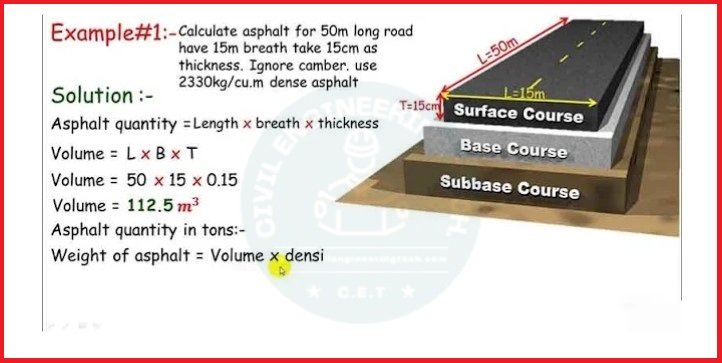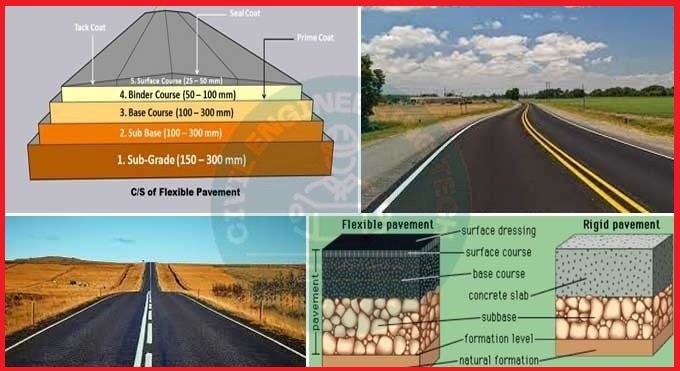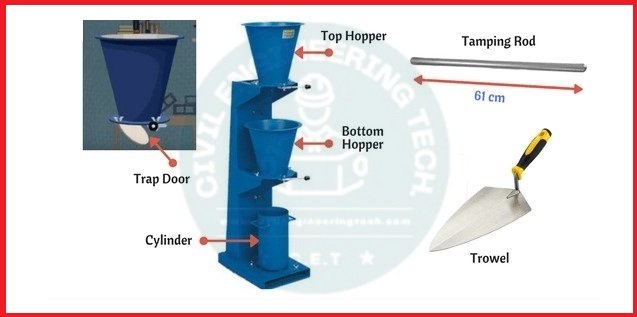How To Calculate the Asphalt Quantity For Road
How To Calculate the Asphalt Quantity For Road

How To Calculate the Asphalt Quantity For Road
Numerous individuals often mistake asphalt for bitumen. Despite common belief, asphalt and the bitumen are not the same from a technical standpoint. How To Calculate the Asphalt Quantity For Road.
Asphalt consists of a blend of aggregates, binder (bitumen), and sand. The aggregates utilized in asphalt mixtures may include crushed rock, sand, gravel and or slags.

Bitumen serves as the liquid adhesive that binds asphalt together, contrary to the common misconception of using the term bitumen interchangeably with asphalt.
Asphalt finds extensive application in the construction and upkeep of the various road types, including highways, urban and rural roads, parking lots, and pathways. The distinction between asphalt and bitumen will be elaborated upon in a separate piece.
Read More
How to Create the Bar Bending Schedule Of Slab
Basics Of Land Surveying
Derivation of formula to set out the curves by the method of ordinates from a long chord
Estimation of the Material for Concrete
In this context, the focus will be on outlining the method for determining the amount of asphalt required and its associated expenses for the road development. The calculation process is straightforward, requiring only a set of specific data.

For Example
Length of the road = L = Five km = 5000 m
Width of the road = W = Six m
Thickness of the asphalt = H = 15 cm = 0.15 m
Qty Of the Asphalt Calculation:
Volume of the asphalt = L x W x H
= 5000 x Six x 0.15 = 4500 m3
Here, the density of the asphalt is taken as 2330 kg/m3
Therefore, qty of the asphalt = Volume of the asphalt x Density of the asphalt
= 4500 x 2330 = 10485000 kg = 10485 tons
Read More
Components of Road Structure
Bar bending schedule for footing
What is contour interval and Uses of contour maps in surveying
how to Calculate the height of an object using With theodolite
Cost of the asphalt:
Suppose the cost of the One ton asphalt is 6000 rs.
Cost of the asphalt = 10485 x 6000 = 62910000 rs
Quantity Of the Asphalt In Curved Road.

For Example
- Width of the road = W = Six m
- Thickness of the asphalt = H = fifteen cm = 0.15 m
Length of the curved road = (π x R x θ)/180 = (3.14 x ten x 100)/180 = 17.44 m
Volume of the asphalt for the curved road = Length x Width x Thickness
= L x W x H = 17.44 x Six x 0.15 = 15.696 m3
Qty of the asphalt for the curved road = Volume of the asphalt x Density of the asphalt
= 15.69 x 2330 = 36558 kg = 36.55 tons
Read More
Concrete Slump Test workability Procedure and result
What is Best Practice in the Construction
Types of Maps in the Drone Mapping
Thumb rule for Civil Engineers
Cost of the asphalt:
Suppose the cost of One ton asphalt is 6000 rs.
Cost of the asphalt = 36.55 x 6000 = 219300 rs
Note
If the area you are calculating has an irregular shape, it is recommended to divide it into multiple regularly-shaped sections. Then, apply the above method to calculate the volume and asphalt requirements for each section individually. Finally, add up the results to obtain the total volume and asphalt requirements for the entire area.
Other Post
What Is The RCC Concrete And Properties of RCC Concrete
What is the Long Wall Short Wall Method
What is the Differences between Pillar and Column
Civil Engineering Interview Questions and Answers
Calculation of Bricks and Blocks in the Wall
Civil Engineering Basic Field Knowledge






I need to daily information about civil work
I need to daily information about civil engineer
Good Expression